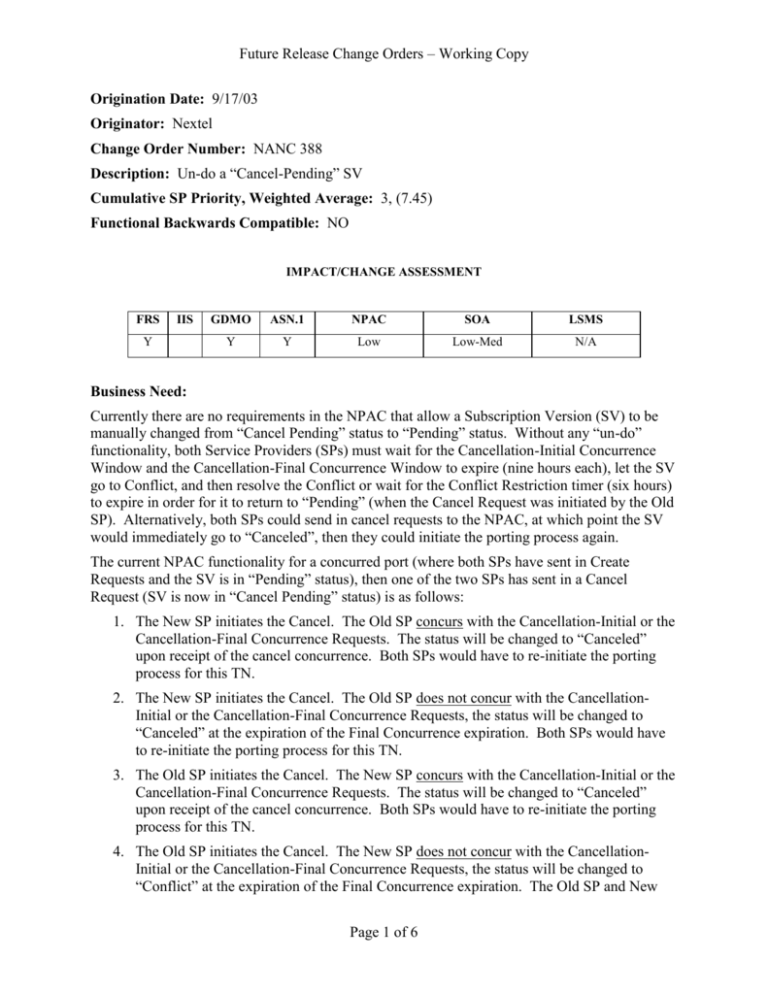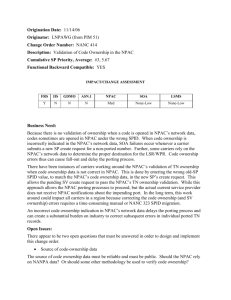NANC 388
advertisement

Future Release Change Orders – Working Copy
Origination Date: 9/17/03
Originator: Nextel
Change Order Number: NANC 388
Description: Un-do a “Cancel-Pending” SV
Cumulative SP Priority, Weighted Average: 3, (7.45)
Functional Backwards Compatible: NO
IMPACT/CHANGE ASSESSMENT
FRS
IIS
Y
GDMO
ASN.1
NPAC
SOA
LSMS
Y
Y
Low
Low-Med
N/A
Business Need:
Currently there are no requirements in the NPAC that allow a Subscription Version (SV) to be
manually changed from “Cancel Pending” status to “Pending” status. Without any “un-do”
functionality, both Service Providers (SPs) must wait for the Cancellation-Initial Concurrence
Window and the Cancellation-Final Concurrence Window to expire (nine hours each), let the SV
go to Conflict, and then resolve the Conflict or wait for the Conflict Restriction timer (six hours)
to expire in order for it to return to “Pending” (when the Cancel Request was initiated by the Old
SP). Alternatively, both SPs could send in cancel requests to the NPAC, at which point the SV
would immediately go to “Canceled”, then they could initiate the porting process again.
The current NPAC functionality for a concurred port (where both SPs have sent in Create
Requests and the SV is in “Pending” status), then one of the two SPs has sent in a Cancel
Request (SV is now in “Cancel Pending” status) is as follows:
1. The New SP initiates the Cancel. The Old SP concurs with the Cancellation-Initial or the
Cancellation-Final Concurrence Requests. The status will be changed to “Canceled”
upon receipt of the cancel concurrence. Both SPs would have to re-initiate the porting
process for this TN.
2. The New SP initiates the Cancel. The Old SP does not concur with the CancellationInitial or the Cancellation-Final Concurrence Requests, the status will be changed to
“Canceled” at the expiration of the Final Concurrence expiration. Both SPs would have
to re-initiate the porting process for this TN.
3. The Old SP initiates the Cancel. The New SP concurs with the Cancellation-Initial or the
Cancellation-Final Concurrence Requests. The status will be changed to “Canceled”
upon receipt of the cancel concurrence. Both SPs would have to re-initiate the porting
process for this TN.
4. The Old SP initiates the Cancel. The New SP does not concur with the CancellationInitial or the Cancellation-Final Concurrence Requests, the status will be changed to
“Conflict” at the expiration of the Final Concurrence expiration. The Old SP and New
Page 1 of 6
Future Release Change Orders – Working Copy
SP must then resolve the conflict, or wait for the Conflict Restriction Window to expire
(six hours) for the SV to be eligible to be changed back to “Pending” by the New SP.
In case #4, the porting process could continue after the expiration of the Cancellation
Concurrence timers (18 hours), and either the resolution of the conflict (0-6 hours) or waiting for
the Conflict timer to expire (6 hours).
Jun ’04 LNPAWG, instead of the previously documented behavior that would include a new
CMIP message (retract SV cancel), the recommendation is to extend the usage of the existing
modify SV message to include the ability to modify the status from cancel-pending back to
pending. Additional business rules and edits will be added to ensure that only the SP that issued
the cancel request is now performing the “un-do” activity.
Description of Change:
The recommendation is for a change to the NPAC functionality, such that an SP that sent up a
Cancel Request in error, could “un-do” the request by sending a “modify request” message
(using a Subscription Version Modify Action) to the NPAC.
This message would allow the SV to change from a “Cancel Pending” status back to it’s previous
status (either “Pending” or “Conflict”). The NPAC would verify that the SP sending the “modify
request” message to the NPAC is the same SP that initiated the Cancel Request (otherwise return
an error).
There would not be any restriction on when this new message could be sent (i.e., during the 18
hour window that the SV is in Cancel Pending).
No backwards-compatibility flags needed. The change in status (from Cancel Pending back to
Pending, or from Cancel Pending back to Conflict) can be handled with the existing Status
Attribute Value Change. However, SPs should verify with their SOA vendors that an SAVC that
is updating a Cancel Pending SV to a Pending SV or Conflict SV will not be rejected.
In order to use this new functionality, an SP would need to implement a change in their SOA.
Nov ’03 LNPAWG, discussion:
Explained the current functionality, and provided an overview of the desired change. Vendor
action item will be in the LNPAWG action items list. We will also investigate and discuss the
question on the status change after a second cancel request from the Old SP.
Jun ’04 LNPAWG, additional business rules and edits will be added to ensure that only the SP
that issued the cancel request is now performing the “un-do” activity using the existing modify
SV message.
Major points/processing flow/high-level requirements:
1. An SV is in cancel-pending status.
2. The Service Provider that issued the cancel message to the NPAC, requests the NPAC to
“un-do” the cancel request:
Page 2 of 6
Future Release Change Orders – Working Copy
a. The Service Provider sends a Subscription Version Modify Action message to the
NPAC for an SV in a cancel-pending state.
b. The NPAC validates the message is from the Service Provider that issued the cancel
request.
i. If yes, continue.
ii. If no, return an error to the requesting Service Provider, and exit the process.
3. The NPAC changes the status of the SV to it’s previous status (either pending or conflict).
4. The NPAC sends a Status Attribute Value Change notification to the involved Service
Providers:
a. New Service Provider receives Status Attribute Value Change notification updating
the status to pending or conflict.
b. Old Service Provider receives Status Attribute Value Change notification updating
the status to pending or conflict.
Requirements:
Req 1 – Un-Do a Cancel-Pending Subscription Version – Notification
NPAC SMS shall inform both Old and New Service Providers when the status of a Subscription
Version is set from cancel-pending back to pending, or from cancel-pending back to conflict for
an Inter-Service Provider port.
Req 2 – Un-Do a Cancel-Pending Subscription Version – Request Data
NPAC SMS shall receive the following data from the Old or New Service Provider to identify a
Subscription Version to have a cancel request retracted:
Ported TN (or a specified range of numbers)
Subscription Version ID
Version Status (if TN or TN range is specified, must be cancel-pending).
New Version Status (can be only pending, in order for it to be returned to a pendinglike status)
Req 2.5 – Un-Do a Cancel-Pending Subscription Version – New Status Specified Error
NPAC SMS shall send an appropriate error message to the originating user that requests a
cancellation retraction for a subscription version, if the new version status specified in the
request is not pending.
Req 3 – Un-Do a Cancel-Pending Subscription Version – Version Status Error
NPAC SMS shall send an appropriate error message to the originating user that requests a
cancellation retraction for a subscription version, if the current version status is not cancelpending.
Page 3 of 6
Future Release Change Orders – Working Copy
Req 5 – Un-Do a Cancel-Pending Subscription Version – Timestamp
NPAC SMS shall set the Subscription Version modification date and time to current upon setting
the Subscription Version status back to pending or conflict.
Req 7 – Un-Do a Cancel-Pending Subscription Version – Missing Cancel Error
NPAC SMS shall return an error if a Service Provider sends a cancellation retraction for a
subscription version that has not been cancelled by that Service Provider.
Req 8 – Un-Do a Cancel-Pending Subscription Version – Status Change
NPAC SMS shall set the subscription version status to Pending or Conflict, returning the status
to the same value as prior to the cancellation that caused it to go into cancel-pending, upon
receiving a cancellation retraction from either the Old or New Service Provider for a subscription
version with a cancel-pending status (both Service Providers have done a create) for an InterService Provider or Port to original port.
Req 9 – Un-Do a Cancel-Pending Subscription Version Tunable
NPAC SMS shall provide an Un-Do a Cancel-Pending Subscription Version tunable parameter
which is defined as the support for providing this functionality within the NPAC SMS.
Req 10 – Un-Do a Cancel-Pending Subscription Version Tunable Default
NPAC SMS shall default the Un-Do a Cancel-Pending Subscription Version tunable parameter
to TRUE.
Req 11 – Un-Do a Cancel-Pending Subscription Version Tunable Modification
NPAC SMS shall allow NPAC Personnel, via the NPAC Administrative Interface, to modify the
Un-Do a Cancel-Pending Subscription Version tunable parameter.
RR5-12.3
Conflict Resolution New Service Provider Restriction Tunable Parameter
NPAC SMS shall provide long and short Conflict Resolution New Service Provider Restriction
tunable parameters which are defined as a number of business hours after the subscription
version is initially put into conflict that the NPAC SMS will prevent it from being removed
from conflict by the New Service Provider.
Note: In the case where a subscription version is put into conflict (status is conflict), then
cancelled (status is cancel-pending), then cancel un-do (status is returned to conflict), the number
of business hours is based on when the subscription version initially went into conflict, not when
it is returned back to conflict.
SV Status Change Diagram:
Update table to describe the arrow in row 3. This new text to be inserted is identical to
row 12 for un-do.
Page 4 of 6
Future Release Change Orders – Working Copy
(column 2) SOA to NPAC SMS Interface or NPAC SOA Low-tech Interface.
(column 3) Service Provider User sends an un-do cancel-pending request for a
Subscription Version with a status of cancel-pending for which the same Service Provider
previously issued a cancel request.
IIS
No Change Required
A new flow for the NPAC will be added in section B.5, Subscription Version. New flow is
shown below:
B.5.x
Un-Do Cancel-Pending SV Request
This scenario can only be performed when the subscriptionVersionStatus is cancel-pending.
Old SOA
New SOA
Modify Request (Un-Do)
NPAC SMS
internal M-SET
internal M-SET
Modify Response (UnDo)
M-Event-Report SAVC
M-Event-Report SAVC
M-Event-Report SAVC
M-Event-Report SAVC
1
2
3
4
5
6
7
8
Step 5 and step 7 will be updated to indicate the new status will be set to either pending or
conflict (i.e., returned to the same status as prior to the cancellation that caused it to go into
cancel-pending)
GDMO
subscriptionVersionModifyBehavior BEHAVIOUR
DEFINED AS !
An SP that sent up a Cancel Request in error, can un-do the cancel
request by setting the Subscription status to pending (returning it to the
same pending-like status as prior to the cancellation that caused the SV to
go into cancel-pending).
This allows the Subscription Version to change from cancel-pending back to
pending, or cancel-pending back to conflict. The NPAC verifies that the SP
sending the modify to the NPAC is the same SP that initiated the Cancel
Request (otherwise return an error).
There is no restriction on when the modify can be sent during the tunable
period of time that the SV is cancel-pending.
!;
Page 5 of 6
Future Release Change Orders – Working Copy
ASN.1
SubscriptionModifyData ::= SEQUENCE {
subscription-lrn [0] LRN OPTIONAL,
subscription-new-sp-due-date [1] GeneralizedTime OPTIONAL,
subscription-old-sp-due-date [2] GeneralizedTime OPTIONAL,
subscription-old-sp-authorization [3] ServiceProvAuthorization OPTIONAL,
subscription-class-dpc [4] EXPLICIT DPC OPTIONAL,
subscription-class-ssn [5] EXPLICIT SSN OPTIONAL,
subscription-lidb-dpc [6] EXPLICIT DPC OPTIONAL,
subscription-lidb-ssn [7] EXPLICIT SSN OPTIONAL,
subscription-isvm-dpc [8] EXPLICIT DPC OPTIONAL,
subscription-isvm-ssn [9] EXPLICIT SSN OPTIONAL,
subscription-cnam-dpc [10] EXPLICIT DPC OPTIONAL,
subscription-cnam-ssn [11] EXPLICIT SSN OPTIONAL,
subscription-end-user-location-value [12] EndUserLocationValue OPTIONAL,
subscription-end-user-location-type [13] EndUserLocationType OPTIONAL,
subscription-billing-id [14] BillingId OPTIONAL,
subscription-status-change-cause-code [15]
SubscriptionStatusChangeCauseCode OPTIONAL,
subscription-wsmsc-dpc [16] EXPLICIT DPC OPTIONAL,
subscription-wsmsc-ssn [17] EXPLICIT SSN OPTIONAL,
subscription-customer-disconnect-date [18] GeneralizedTime OPTIONAL,
subscription-effective-release-date [19] GeneralizedTime OPTIONAL,
new-version-status [20] VersionStatus OPTIONAL
}
SubscriptionModifyInvalidData ::= CHOICE {
subscription-lrn [0] EXPLICIT LRN,
subscription-new-sp-due-date [1] EXPLICIT GeneralizedTime,
subscription-old-sp-due-date [2] EXPLICIT GeneralizedTime,
subscription-old-sp-authorization [3] EXPLICIT ServiceProvAuthorization,
subscription-class-dpc [4] EXPLICIT DPC,
subscription-class-ssn [5] EXPLICIT SSN,
subscription-lidb-dpc [6] EXPLICIT DPC,
subscription-lidb-ssn [7] EXPLICIT SSN,
subscription-isvm-dpc [8] EXPLICIT DPC,
subscription-isvm-ssn [9] EXPLICIT SSN,
subscription-cnam-dpc [10] EXPLICIT DPC,
subscription-cnam-ssn [11] EXPLICIT SSN,
subscription-end-user-location-value [12] EXPLICIT EndUserLocationValue,
subscription-end-user-location-type [13] EXPLICIT EndUserLocationType,
subscription-billing-id [14] EXPLICIT BillingId,
subscription-status-change-cause-code [15]
EXPLICIT SubscriptionStatusChangeCauseCode,
subscription-wsmsc-dpc [16] EXPLICIT DPC,
subscription-wsmsc-ssn [17] EXPLICIT SSN,
subscription-customer-disconnect-date [18] EXPLICIT GeneralizedTime,
subscription-effective-release-date [19] EXPLICIT GeneralizedTime,
new-version-status [20] EXPLICIT VersionStatus
}
Page 6 of 6







